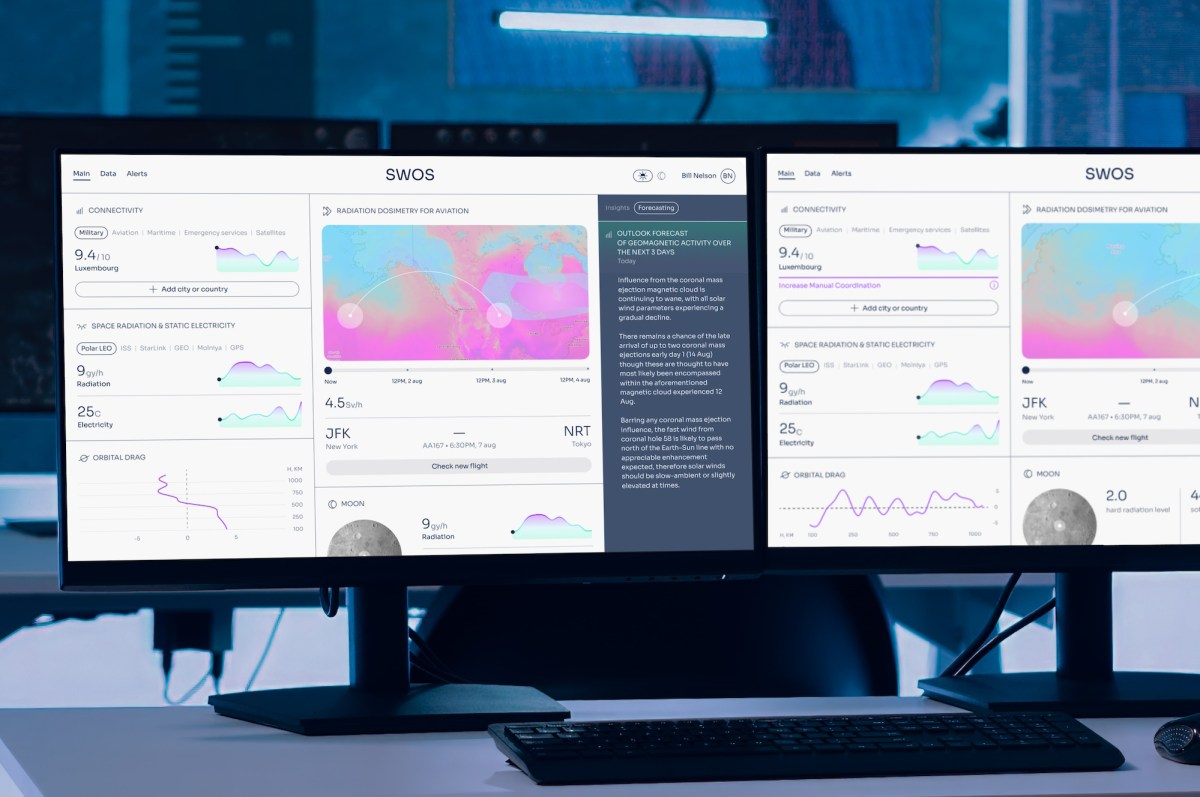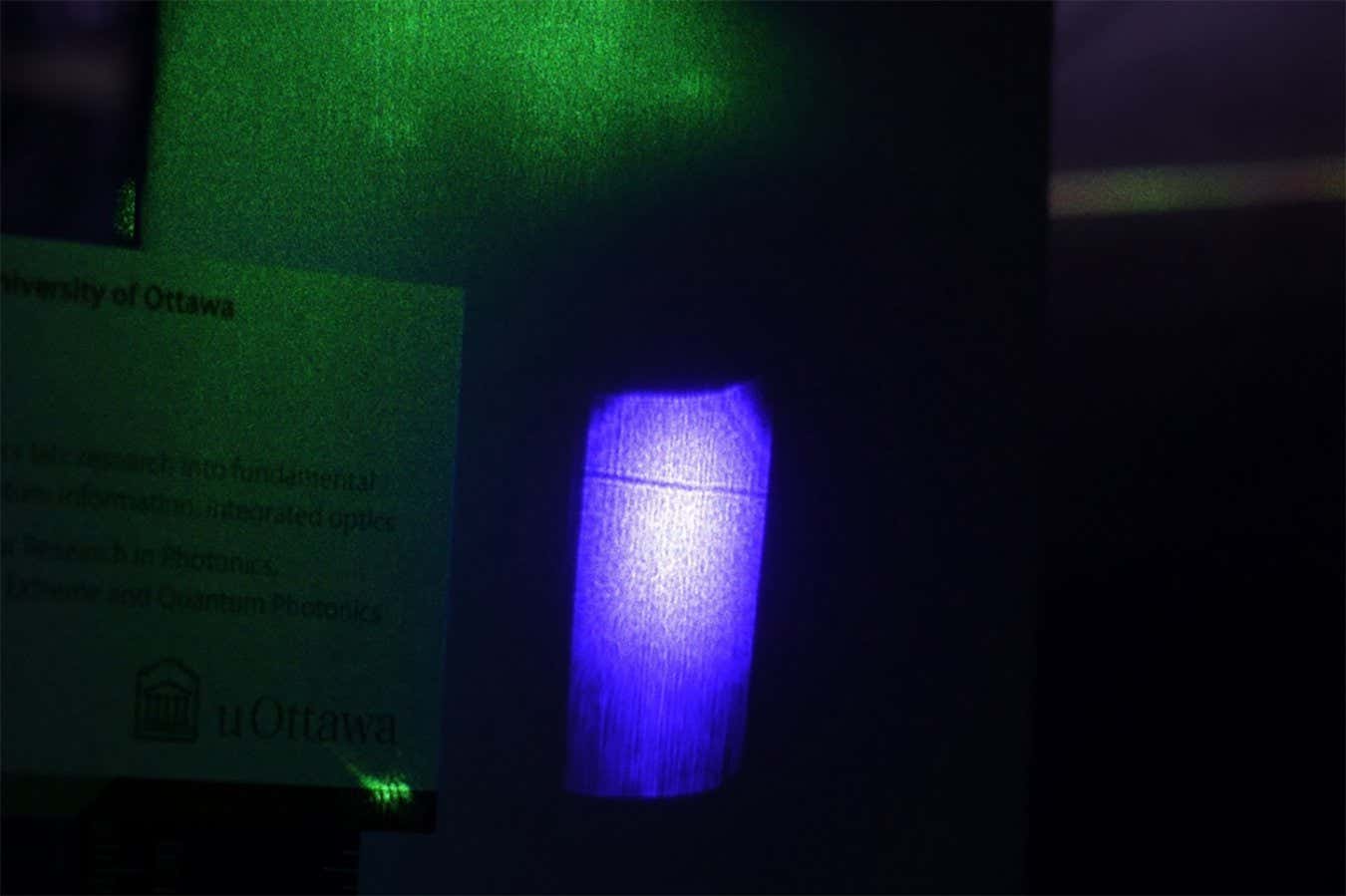In the weeks leading up to the US presidential election, Kacey Smith was feeling hopeful. Smith, who supported Vice President Kamala Harris’ campaign, says she knew it would be a close race between the Democratic nominee and Republican Donald Trump. But as she scrolled TikTok, she believed Harris would be victorious.
Technology
How Microsoft’s next-gen BitNet architecture is turbocharging LLM efficiency

Join our daily and weekly newsletters for the latest updates and exclusive content on industry-leading AI coverage. Learn More
One-bit large language models (LLMs) have emerged as a promising approach to making generative AI more accessible and affordable. By representing model weights with a very limited number of bits, 1-bit LLMs dramatically reduce the memory and computational resources required to run them.
Microsoft Research has been pushing the boundaries of 1-bit LLMs with its BitNet architecture. In a new paper, the researchers introduce BitNet a4.8, a new technique that further improves the efficiency of 1-bit LLMs without sacrificing their performance.
The rise of 1-bit LLMs
Traditional LLMs use 16-bit floating-point numbers (FP16) to represent their parameters. This requires a lot of memory and compute resources, which limits the accessibility and deployment options for LLMs. One-bit LLMs address this challenge by drastically reducing the precision of model weights while matching the performance of full-precision models.
Previous BitNet models used 1.58-bit values (-1, 0, 1) to represent model weights and 8-bit values for activations. This approach significantly reduced memory and I/O costs, but the computational cost of matrix multiplications remained a bottleneck, and optimizing neural networks with extremely low-bit parameters is challenging.
Two techniques help to address this problem. Sparsification reduces the number of computations by pruning activations with smaller magnitudes. This is particularly useful in LLMs because activation values tend to have a long-tailed distribution, with a few very large values and many small ones.
Quantization, on the other hand, uses a smaller number of bits to represent activations, reducing the computational and memory cost of processing them. However, simply lowering the precision of activations can lead to significant quantization errors and performance degradation.
Furthermore, combining sparsification and quantization is challenging, and presents special problems when training 1-bit LLMs.
“Both quantization and sparsification introduce non-differentiable operations, making gradient computation during training particularly challenging,” Furu Wei, Partner Research Manager at Microsoft Research, told VentureBeat.
Gradient computation is essential for calculating errors and updating parameters when training neural networks. The researchers also had to ensure that their techniques could be implemented efficiently on existing hardware while maintaining the benefits of both sparsification and quantization.
BitNet a4.8
BitNet a4.8 addresses the challenges of optimizing 1-bit LLMs through what the researchers describe as “hybrid quantization and sparsification.” They achieved this by designing an architecture that selectively applies quantization or sparsification to different components of the model based on the specific distribution pattern of activations. The architecture uses 4-bit activations for inputs to attention and feed-forward network (FFN) layers. It uses sparsification with 8 bits for intermediate states, keeping only the top 55% of the parameters. The architecture is also optimized to take advantage of existing hardware.
“With BitNet b1.58, the inference bottleneck of 1-bit LLMs switches from memory/IO to computation, which is constrained by the activation bits (i.e., 8-bit in BitNet b1.58),” Wei said. “In BitNet a4.8, we push the activation bits to 4-bit so that we can leverage 4-bit kernels (e.g., INT4/FP4) to bring 2x speed up for LLM inference on the GPU devices. The combination of 1-bit model weights from BitNet b1.58 and 4-bit activations from BitNet a4.8 effectively addresses both memory/IO and computational constraints in LLM inference.”
BitNet a4.8 also uses 3-bit values to represent the key (K) and value (V) states in the attention mechanism. The KV cache is a crucial component of transformer models. It stores the representations of previous tokens in the sequence. By lowering the precision of KV cache values, BitNet a4.8 further reduces memory requirements, especially when dealing with long sequences.
The promise of BitNet a4.8
Experimental results show that BitNet a4.8 delivers performance comparable to its predecessor BitNet b1.58 while using less compute and memory.
Compared to full-precision Llama models, BitNet a4.8 reduces memory usage by a factor of 10 and achieves 4x speedup. Compared to BitNet b1.58, it achieves a 2x speedup through 4-bit activation kernels. But the design can deliver much more.
“The estimated computation improvement is based on the existing hardware (GPU),” Wei said. “With hardware specifically optimized for 1-bit LLMs, the computation improvements can be significantly enhanced. BitNet introduces a new computation paradigm that minimizes the need for matrix multiplication, a primary focus in current hardware design optimization.”
The efficiency of BitNet a4.8 makes it particularly suited for deploying LLMs at the edge and on resource-constrained devices. This can have important implications for privacy and security. By enabling on-device LLMs, users can benefit from the power of these models without needing to send their data to the cloud.
Wei and his team are continuing their work on 1-bit LLMs.
“We continue to advance our research and vision for the era of 1-bit LLMs,” Wei said. “While our current focus is on model architecture and software support (i.e., bitnet.cpp), we aim to explore the co-design and co-evolution of model architecture and hardware to fully unlock the potential of 1-bit LLMs.”
Source link
Technology
Mission Space launches next quarter to provide real-time space weather forecasts

When you board a plane, the pilot already knows the weather on the flight path and can steer clear, or at least warn you it’s coming. The same can’t be said of “space weather” from solar events, which can seriously affect satellites and even passenger planes.
Mission Space is about to launch a constellation provide near-real-time monitoring of this increasingly important phenomenon.
Space weather is a general term for the radiation in the near-Earth environment; outside the planet’s protective aura, satellites and spacecraft feel the full brunt of the sun’s rays, and a solar storm can interfere with or disable them. The type and intensity of this radiation shifts and flows just like atmospheric weather, but being invisible and moving at the speed of light, it’s considerably more difficult to observe and predict.
There are numerous satellites and deep-space missions that monitor solar radiation, but they are necessarily limited; imagine trying to predict the path of a storm using only a handful of wind and rain sensors scattered across the ocean. And while historically this has been sufficient, the growth of the new space economy has transformed space weather from an occasional inconvenience to a constant and quantifiable threat.
“More and more companies are putting space weather on their agenda,” said Alex Po, CEO and founder of Mission Space. “We have 7,000 satellites in space, but in ten years it’ll be 50,000; that means space weather events will be the same as now, but they will have ten times the impact.”
A serious solar storm is not dangerous not only to electronics, but also to unprepared astronauts. If someone happens to be doing a spacewalk, they could get a face full of radiation — and if we want to establish a permanent presence on the Moon, where there’s similarly little protection, we’ll want to know exactly when it’s safe to go outside.
Nearer the surface, airlines are concerned about passengers getting large doses of radiation during a long flight over the poles, and some have even canceled flights because of it. And there are numerous secondary effects on services that rely on satellites, including precision agriculture.

Po’s startup, originally founded in Europe but now based in Israel and the U.S., is about to launch the first two of a planned 24-satellite constellation that will monitor space weather and provide reports and predictions in near real time.
It’s not intended to replace the scientific instruments currently in space, but augment their data (much of which is public) with a voluminous, proprietary stream that enables more precise, timely monitoring.
Po explained that while many companies and governments are increasingly aware of the need for better space weather prediction, the satellites are aging and the data is difficult to share.
“The infrastructure for space weather monitoring was developed in the late 90s, and many of the scientific models were developed 50 years ago,” Po said. Information sharing agreements between organizations like NASA, NOAA, and ESA are complex, and the data itself is not trivial to integrate and harmonize.
“There are no people in the companies who need this data who can understand it. What’s needed is, say, alerts for different alert levels for launch, or for airlines. Everyone uses weather data but no one thinks about how it is generated: you just want to know if it’s going to rain or not. It’s the same here,” he continued.
Mission Space currently uses public sources, doing the work of normalizing it to create something of a unified data stream. But they are launching the first two of their own satellites in the first quarter of 2025, with more planned for later that year. Po said they could probably launch faster, but that it’s more beneficial to learn from the first set and improve as they go. “Engineers…” he said, “There are always more changes.”

The satellites themselves (named Zohar) are specialized but not exotic, he noted, leading to a lower cost for a constellation of 24 than you might expect. The important part is that they still collect 15 parameters a thousand times a second.
“Space weather is a data monopoly game: the first to launch the constellation and build the infrastructure will win,” he predicted. “Even with half a constellation, in two years we will generate a thousand times more space weather data than humans have generated in the last 60. And the real-time data will let us develop machine learning models based on it.”
They are not in competition with governments and scientific organizations, he claimed, or really even startups looking to serve those customers — collaboration is a necessity for a number of reasons.
Their customers are “aerospace in general; satellite operators and space tourism companies; anyone doing private space stations. They’re all very aware of the problem,” said Po. “It was common knowledge in the aviation industry but now the companies are actually paying attention to solutions. And of course for defense, they’ve been developing the domain, and you must be sure you will not have issues in critical space operations. With the current level of precision, that’s hard for them.”
While the real-time readings and predictions will have to wait for the full constellation, the pair going up in a few months should offer a marked improvement over the existing offerings. No exact date is set for launch.
Technology
Pro-Harris TikTok felt safe in an algorithmic bubble — until election day

But Election Day approached, and she started to sense red flags in that positivity. She recalls TikTok serving her enthusiasm for reproductive choice with videos encouraging “women’s rights over gas prices” — implying, falsely, she thought, the choice was “either/or.” The rhetoric fit well inside her feed filled with strangers, but as a campaign strategy, it felt limiting and risky. “When I started seeing that messaging play out,” Smith says, “I started getting a little uneasy.” Her fears were borne out: Harris lost the popular vote and Electoral College and conceded the election to President-elect Trump.
Filter bubbles like TikTok’s recommendation algorithm are a common point of concern among tech critics. The feeds can create the impression of a bespoke reality, letting users avoid things they find unpleasant — like the real people in Smith’s life who supported Trump. But while there are frequent complaints that algorithmic feeds could serve users misinformation or lull them into complacency, that’s not exactly what happened here. Voters like Smith understood the facts and the odds. They just underestimated how convincingly something like TikTok’s feed could build a world that didn’t quite exist — and in the wake of Harris’ defeat, they’re mourning its loss, too.
TikTok’s algorithm is hyperpersonalized, like a TV station calibrated exactly to a user’s brain. Its For You page serves content based on what you’ve previously watched or scrolled away from, and breaking out of these recommendations into other circles of the app isn’t easy. It’s a phenomenon political activists must figure out how to adapt to, says Cristina Tzintzún Ramirez, president of progressive youth voter organization NextGen America.
“It not only makes it harder for us to do our job, I think it makes it harder for candidates to do their jobs. It makes it harder for news media to do their job, because now you’re talking about having to inform a public that has so many different sources of information,” she says.
From the onset, the Harris campaign seemed to understand the power of these silos. On TikTok, where the Kamala HQ account has 5.7 million followers, an all-Gen Z team of staffers produced video after video that are, at times, indecipherable to the average person. If you saw a video stringing together clips of Harris saying things like “Donald Trump was fired by 81 million people” and “I have a Glock” with a gentle Aphex Twin song as the soundtrack, would you understand it as “hopecore”? The campaign bet that it didn’t really matter because the TikTok algorithm would carry it to people who did understand it. And at least to some extent, they were right.
Smith, like other TikTok users, knows that the platform recommends her content based on what she watches, saves, comments on, or likes. When pro-Trump content came across her For You page, Smith would purposely not engage and simply scroll away.
“I don’t want my algorithm to think that I’m a Trump supporter, so I just want to scroll up and ignore it,” she says.
In hindsight, Smith wonders if that was the right thing to do or if a mix of different types of political content may have given her more insight into what the other side was saying, doing, and thinking. She likens it to being a liberal or progressive who consumes news from right-wing outlets like Breitbart or Fox News — not because you agree with the material, but because it’s helpful to know what messages are resonating with other types of voters.
The echo chamber effect isn’t limited to politics: we don’t even really know what is popular on TikTok generally. Some of what we see may not be guided by our preferences at all. A report by The Washington Post found that male users — even liberal men — were more likely to be served Trump content on TikTok than women. According to data from Pew Research Center, about 4 in 10 young people regularly get news from TikTok.
TikTok obviously isn’t the only filter bubble out there. Two years into Elon Musk’s purchase of Twitter, now called X, the platform has morphed into a right-wing echo chamber, with content boosted by Musk himself. While TikTok is simply (as far as we know) serving people things they like to sell ads, the slant on X was a deliberate electoral strategy that paid off handsomely for Musk.
“I don’t think we know the full implications of X’s algorithm being rigged to feed us right wing propaganda,” Tzintzún Ramirez of NextGen America says. A recent Washington Post analysis found that right-wing accounts have come to dominate visibility and engagement on X. That includes an algorithmic boost to Musk’s own posts, as the billionaire angles for influence with the incoming administration.
Unlike somebody drinking from Musk’s algorithmic fire hose, a young person deep in a pro-Harris TikTok bubble likely wasn’t being fed racist “great replacement” theory stories or false claims about election fraud. Instead, they were probably seeing videos from some of the hundreds of content creators the Democratic Party worked with. Though the direct impact of influencers on electoral politics is difficult to measure, NextGen America’s own research suggests that influencer content may turn out more first-time voters.
“I should know better than to be fooled”
Alexis Williams is the type of influencer that Democrats were hoping could carry their message to followers. For the last several years, Williams has made content about politics and social issues and attended the Democratic National Convention this year as a content creator, sharing her reflections with 400,000 followers across TikTok and Instagram. Though Harris wasn’t a perfect candidate in Williams’ eyes, she felt Harris would win the presidency in the days leading up to the election.
“As someone with a literal engineering degree, I should know better than to be fooled,” Williams says. She was fed TikToks about a bombshell poll showing Harris ahead in Iowa; young women in Pennsylvania going to the polls in support of Harris; analysis about why it was actually going to be a landslide. Professional polls consistently showed a dead heat between Trump and Harris — but watching TikTok after TikTok, it’s easy to shake off any uncertainty. It was a world full of what’s frequently dubbed “hopium”: media meant to fuel what would, in retrospect, look like unreasonable optimism.
TikTok and the Harris campaign didn’t respond to The Verge’s requests for comment.
For many voters on TikTok, the Kamala HQ content fit in seamlessly with other videos. The campaign used the same trending sound clips and music and a casual way of talking to viewers that seemed, at times, borderline unserious. (The Trump campaign also used popular songs and post formats but didn’t seem as native to the platform — more like a politician’s attempt at TikTok.) But Smith says that even as a Harris supporter, there was a limit to how much of that she could stomach. At a certain point, the trends get old, the songs get overplayed, and the line between a political campaign and everything else on TikTok starts to get blurry. Kamala HQ, Smith says, started to feel like just another brand.
Williams’ confidence began to break down on Election Day, as she walked to a watch party. “I know what I’m seeing on the internet and everything, but I still had [something] in my heart that was like, I don’t see us having another Donald Trump presidency, but I also don’t see a world where a Black woman gets elected for president right now,” she says. She started to wonder whether that much had changed in the eight years since the last female presidential candidate. “You’re seeing all this stuff, and people are getting so excited, but this could be just a mirage.”
Filter bubbles are not a new phenomenon, and voters have a wide range of places to get hyperpartisan news apart from TikTok: blogs, talk radio, podcasts, TV. Whether on the right or the left, there’s a tendency to look around at what you see and assume it’s representative. But the false sense of certainty that TikTok brings is perhaps even more powerful. What we see on the platform is both uncomfortably personal and incredibly global: a video talking about something that happened on our neighborhood block might be followed up by someone across the country voting for the same candidate for the same reasons. It gives an illusion that you are receiving a diverse assortment of content and voices.
As social media algorithms have gotten more precise, our window into their inner workings has gotten even smaller. This summer, Meta shut down CrowdTangle, a research tool used to track viral content on Facebook. A public TikTok feature called Creative Center — which allowed advertisers to measure trending hashtags — was abruptly restricted by the company after reporters used it to report on the Israel-Hamas war. It is harder than ever to understand what’s happening on social media, especially outside of our bubbles.
“As technology gets more advanced and more convincing, our idea of a communal reality might genuinely become archaic,” Williams says. “This election has really taught me that we are very much sucked into these worlds that we create on our phone, when the real world is right in front us.”
Technology
D-Link devices are already being attacked after the company said it would no longer support them


- Earlier this week, researchers discover a 9.2 flaw affecting multiple NAS models
- D-Link says it won’t patch them since they reached end-of-life status
- Crooks are now targeting them with available exploit code
Cybercriminals have begun targeting D-Link NAS devices, recently found to have a critical vulnerability, but which will not be patched due to being at their end of life.
Threat monitoring service Shadowserver recently sounded the alarm in a brief thread posted on X.
It was recently reported multiple versions of D-Link NAS devices were vulnerable to a 9.2-severity flaw that could allow hackers to interfere with the endpoints. However, as the devices had reached their end-of-life, the company said it would not be addressing the flaw, and would not be issuing a patch – instead, advising users to replace the devices with newer models.
Thousand(s) of victims
While the researchers said the exploitation was somewhat difficult since the complexity of an attack was relatively high, they did stress that there is a publicly available exploit out there.
“We have observed D-Link NAS CVE-2024-10914 /cgi-bin/account_mgr.cgi command injection exploitation attempts starting Nov 12th,” the researchers said. “This vuln affects EOL/EOS devices, which should be removed from the Internet.”
They added that in total, there were more than 60,000 endpoints out there that could be compromised, including different models such as DNS-320 Version 1.00,
DNS-320LW Version 1.01.0914.2012, DNS-325 Version 1.01, Version 1.02, and DNS-340L Version 1.08.
Shadowserver also said that it observed roughly 1,100 potential victims, significantly fewer than the 60,000 that were originally claimed.
A NAS device is a dedicated data storage unit connected to a network, allowing multiple users and devices to access and store data centrally. It provides secure file sharing, data backup, and storage, making it ideal for both home and business use. NAS devices are typically easy to set up and scale, offering RAID support and other protections against data loss.
Cybercriminals frequently target NAS devices because they often hold sensitive data, including personal documents, financial information, and business files. By compromising NAS systems, attackers can steal, encrypt, or delete valuable data, with ransomware being a common threat.
Via BleepingComputer
You might also like
Science & Environment
Bizarre test shows light can actually cast its own shadow


The shadow of a laser beam appears as a horizontal line against the blue background
Abrahao et al. (2024)
Light normally makes other objects cast shadows – but with a little help from a ruby, a beam of laser light can cast a shadow of its own.
When two laser beams interact, they don’t clash together like lightsabers in Star Wars, says Raphael Abrahao at Brookhaven National Laboratory in New York. In real life, they will simply pass through each other. Abrahao and his colleagues, however, found a way for one laser beam to block another – and make its shadow appear.
The crucial ingredient was a ruby cube. The researchers hit this cube with a beam of green laser light while illuminating it with a blue laser from the side. As the green light passed through the ruby atoms, it changed their properties in a peculiar way that then affected how they reacted to the blue light.
Instead of letting the blue laser pass through them, the atoms affected by the green light now blocked the blue light, which created a shadow shaped exactly like the green laser beam. Remarkably, the researchers could project the blue light on a screen and see this “shadow of a laser” with the naked eye.
Abrahao says he and his colleagues had a long discussion of whether what they created really qualified as a shadow. Because it moved when they moved the green laser beam, they could see it without any special equipment and they managed to project it onto commonplace objects, like a marker, they ultimately decided in the affirmative.
Historically, understanding shadows has been crucial for understanding what light can do and how we can use it, he says, and this experiment adds an unexpected technique into scientists’ light-manipulation toolbox.
Tomás Chlouba at the University of Erlangen–Nuremberg in Germany says the experiment uses known processes to create a striking visual demonstration of how materials can help control light. The ruby’s interactions with the laser, for instance, are similar to those of materials used in laser eye surgeries, which must be able to respond to laser light by blocking it if it gets dangerously intense.
Topics:
Technology
Meta fined €798m over ‘unfair’ Facebook Marketplace

Meta has been fined €798m (£664m) for breaking competition law by embedding Facebook Marketplace within its social network.
The European Commission said this meant alternative classified ads services had faced “unfair trading conditions”, making it harder for them to compete.
In addition to the fine, it has ordered Meta to stop imposing these conditions on other services.
Meta said it rejected the Commission’s findings and would appeal.
EU antitrust head Margrethe Vestager said Facebook had impeded other online classified ads service providers.
“It did so to benefit its own service Facebook Marketplace, thereby giving it advantages that other online classified ads service providers could not match,” she added,
She said Meta “must stop this behaviour”, with the EU asking the firm to “refrain from repeating” the infringement.
Meta said the Commission had provided “no evidence” of harm either to competitors or consumers.
“This decision ignores the market realities, and will only serve to protect incumbent marketplaces from competition.”
The ruling is the result of an investigation which the Commission opened in 2021, after Meta’s rivals complained that Facebook Marketplace gave it an unfair advantage.
Meta has not previously faced a fine from the EU over competition rules – though it was told to pay €110m in 2017 for not handing over correct information when it purchased WhatsApp.
The Irish Data Protection Commissioner has also previously fined Meta more than €1bn over mishandling people’s data when transferring it between Europe and the United States.
And it also had to pay a comparatively tiny £50m in 2021, when the UK’s Competition and Markets Authority (CMA) accused it of deliberately breaking rules over its attempt to acquire Gif-maker Giphy – and ultimately demanded it sell the company altogether.
The decision comes as regulators are taking a firmer stance with big tech companies worldwide, with the US government considering a breakup of Google.
Technology
3 great BritBox shows you should watch in November 2024


Netflix is great, but you as you peruse it and all the other American streaming options out there, you might find that there’s still something missing from your streaming diet. If you feel that way, you might consider checking out the many shows available on BritBox. The streaming service imports all of the best of what British TV has to offer.
If you’re looking through BritBox and wondering what to watch this month, we’ve got you covered. We’ve pulled together three of the best shows available on BritBox that you can check out in the month of November.
We also have guides to the best movies on Netflix, the best movies on Hulu, the best movies on Amazon Prime Video, the best movies on Max, and the best movies on Disney+.
Wagatha: A Courtroom Drama (2022)
Dramatizing a real-life defamation case, Wagatha tells the story of Vardy v. Rooney, a 2019 case in which Coleen Rooney stated in a social media post that she had been conducting an extended sting operation to discover who was leaking “false stories” about her life to the Sun. She claimed that Rebekah Vardy was behind the leaks, and this dramatization uses actual court transcripts to bring the case to life.
Starring Good Omens actor Michael Sheen, the series is hugely compelling in part because it feels a little bit stranger than any fictional tale could be. It’s social media drama brought to life, and it’s more riveting than that description sounds.
You can watch Wagatha: A Courtroom Drama on BritBox.
River (2015)
The Brits are truly experts at producing exceptional detective series, and River is a perfect example. The series stars Stellan Skarsgård as a brilliant but unstable detective who finds himself haunted by the ghosts of the murder victims he’s investigated. As he investigates the death of one of his colleagues, his increasingly erratic behavior begins to concern his fellow officers.
Skarsgård is excellent in the lead role, and River is compelling in part because it really questions whether this particular detective’s brilliance is worth all the pain that he causes. River is only a single season, but you’ll love every minute of it.
You can watch River on BritBox.
REG (2016)
A brilliant and overtly political series based on a true story, REG follows a father who runs as an anti-war independent candidate in the 2005 parliamentary elections after the death of his son. As he searches for answers for what happened during the war, he becomes a lightning rod for the anger that had been building around the Iraq War since it started.
Released just a decade after the events it depicts, REG is explicitly about the way Tony Blair lied to the people he was supposed to be serving, and led the U.K. into a war that turned out to be a disaster.
You can watch REG on BritBox.
-

 Science & Environment2 months ago
Science & Environment2 months agoHow to unsnarl a tangle of threads, according to physics
-

 Technology2 months ago
Technology2 months agoWould-be reality TV contestants ‘not looking real’
-

 Technology2 months ago
Technology2 months agoIs sharing your smartphone PIN part of a healthy relationship?
-

 Science & Environment2 months ago
Science & Environment2 months agoHyperelastic gel is one of the stretchiest materials known to science
-

 Science & Environment2 months ago
Science & Environment2 months agoX-rays reveal half-billion-year-old insect ancestor
-

 Science & Environment2 months ago
Science & Environment2 months ago‘Running of the bulls’ festival crowds move like charged particles
-

 Science & Environment2 months ago
Science & Environment2 months agoPhysicists have worked out how to melt any material
-

 MMA1 month ago
MMA1 month ago‘Dirt decision’: Conor McGregor, pros react to Jose Aldo’s razor-thin loss at UFC 307
-

 News1 month ago
News1 month ago‘Blacks for Trump’ and Pennsylvania progressives play for undecided voters
-

 News1 month ago
News1 month agoWoman who died of cancer ‘was misdiagnosed on phone call with GP’
-

 Money1 month ago
Money1 month agoWetherspoons issues update on closures – see the full list of five still at risk and 26 gone for good
-

 Sport1 month ago
Sport1 month agoAaron Ramsdale: Southampton goalkeeper left Arsenal for more game time
-

 Football1 month ago
Football1 month agoRangers & Celtic ready for first SWPL derby showdown
-

 Sport1 month ago
Sport1 month ago2024 ICC Women’s T20 World Cup: Pakistan beat Sri Lanka
-

 Science & Environment2 months ago
Science & Environment2 months agoA new kind of experiment at the Large Hadron Collider could unravel quantum reality
-
Business1 month ago
how UniCredit built its Commerzbank stake
-

 Science & Environment2 months ago
Science & Environment2 months agoMaxwell’s demon charges quantum batteries inside of a quantum computer
-

 Science & Environment2 months ago
Science & Environment2 months agoSunlight-trapping device can generate temperatures over 1000°C
-

 Science & Environment2 months ago
Science & Environment2 months agoLiquid crystals could improve quantum communication devices
-

 Science & Environment2 months ago
Science & Environment2 months agoQuantum forces used to automatically assemble tiny device
-

 Science & Environment2 months ago
Science & Environment2 months agoLaser helps turn an electron into a coil of mass and charge
-

 Technology2 months ago
Technology2 months agoUkraine is using AI to manage the removal of Russian landmines
-
Business1 month ago
Top shale boss says US ‘unusually vulnerable’ to Middle East oil shock
-

 Technology1 month ago
Technology1 month agoSamsung Passkeys will work with Samsung’s smart home devices
-

 MMA1 month ago
MMA1 month agoPereira vs. Rountree prediction: Champ chases legend status
-

 News1 month ago
News1 month agoNavigating the News Void: Opportunities for Revitalization
-

 Science & Environment2 months ago
Science & Environment2 months agoQuantum ‘supersolid’ matter stirred using magnets
-

 Technology2 months ago
Technology2 months agoRussia is building ground-based kamikaze robots out of old hoverboards
-

 Science & Environment2 months ago
Science & Environment2 months agoWhy this is a golden age for life to thrive across the universe
-

 News1 month ago
News1 month agoMassive blasts in Beirut after renewed Israeli air strikes
-

 Technology1 month ago
Technology1 month agoGmail gets redesigned summary cards with more data & features
-

 News1 month ago
News1 month agoCornell is about to deport a student over Palestine activism
-

 Technology1 month ago
Technology1 month agoSingleStore’s BryteFlow acquisition targets data integration
-

 Technology2 months ago
Technology2 months agoMicrophone made of atom-thick graphene could be used in smartphones
-

 Business1 month ago
Business1 month agoWater companies ‘failing to address customers’ concerns’
-

 Sport1 month ago
Sport1 month agoBoxing: World champion Nick Ball set for Liverpool homecoming against Ronny Rios
-

 Sport1 month ago
Sport1 month agoShanghai Masters: Jannik Sinner and Carlos Alcaraz win openers
-

 Entertainment1 month ago
Entertainment1 month agoBruce Springsteen endorses Harris, calls Trump “most dangerous candidate for president in my lifetime”
-

 Money1 month ago
Money1 month agoTiny clue on edge of £1 coin that makes it worth 2500 times its face value – do you have one lurking in your change?
-

 Technology1 month ago
Technology1 month agoEpic Games CEO Tim Sweeney renews blast at ‘gatekeeper’ platform owners
-

 MMA1 month ago
MMA1 month agoPennington vs. Peña pick: Can ex-champ recapture title?
-

 Technology2 months ago
Technology2 months agoMeta has a major opportunity to win the AI hardware race
-

 Science & Environment2 months ago
Science & Environment2 months agoITER: Is the world’s biggest fusion experiment dead after new delay to 2035?
-

 MMA1 month ago
MMA1 month agoDana White’s Contender Series 74 recap, analysis, winner grades
-

 MMA1 month ago
MMA1 month agoKayla Harrison gets involved in nasty war of words with Julianna Pena and Ketlen Vieira
-

 Sport1 month ago
Sport1 month agoAmerica’s Cup: Great Britain qualify for first time since 1964
-

 Technology1 month ago
Technology1 month agoMicrosoft just dropped Drasi, and it could change how we handle big data
-

 Technology1 month ago
Technology1 month agoLG C4 OLED smart TVs hit record-low prices ahead of Prime Day
-

 Sport1 month ago
Sport1 month agoWXV1: Canada 21-8 Ireland – Hosts make it two wins from two
-

 Science & Environment2 months ago
Science & Environment2 months agoNuclear fusion experiment overcomes two key operating hurdles
-

 News2 months ago
News2 months ago▶️ Hamas in the West Bank: Rising Support and Deadly Attacks You Might Not Know About
-

 Technology2 months ago
Technology2 months agoWhy Machines Learn: A clever primer makes sense of what makes AI possible
-

 News1 month ago
News1 month agoHarry vs Sun publisher: ‘Two obdurate but well-resourced armies’
-

 MMA1 month ago
MMA1 month ago‘Uncrowned queen’ Kayla Harrison tastes blood, wants UFC title run
-
Travel1 month ago
World of Hyatt welcomes iconic lifestyle brand in latest partnership
-
Business1 month ago
It feels nothing like ‘fine dining’, but Copenhagen’s Kadeau is a true gift
-

 Football1 month ago
Football1 month ago'Rangers outclassed and outplayed as Hearts stop rot'
-

 Sport1 month ago
Sport1 month agoNew Zealand v England in WXV: Black Ferns not ‘invincible’ before game
-

 Science & Environment2 months ago
Science & Environment2 months agoNerve fibres in the brain could generate quantum entanglement
-

 Technology2 months ago
Technology2 months agoUniversity examiners fail to spot ChatGPT answers in real-world test
-

 Sport1 month ago
Sport1 month agoURC: Munster 23-0 Ospreys – hosts enjoy second win of season
-

 News2 months ago
News2 months agoRwanda restricts funeral sizes following outbreak
-

 Technology1 month ago
Technology1 month agoCheck, Remote, and Gusto discuss the future of work at Disrupt 2024
-

 TV1 month ago
TV1 month agoসারাদেশে দিনব্যাপী বৃষ্টির পূর্বাভাস; সমুদ্রবন্দরে ৩ নম্বর সংকেত | Weather Today | Jamuna TV
-
Business1 month ago
Italy seeks to raise more windfall taxes from companies
-

 MMA1 month ago
MMA1 month agoStephen Thompson expects Joaquin Buckley to wrestle him at UFC 307
-
Business1 month ago
The search for Japan’s ‘lost’ art
-

 Sport1 month ago
Sport1 month agoPremiership Women’s Rugby: Exeter Chiefs boss unhappy with WXV clash
-
Politics1 month ago
‘The night of the living dead’: denial-fuelled Tory conference ends without direction | Conservative conference
-

 Technology1 month ago
Technology1 month agoNintendo’s latest hardware is not the Switch 2
-

 Science & Environment2 months ago
Science & Environment2 months agoA tale of two mysteries: ghostly neutrinos and the proton decay puzzle
-

 Business1 month ago
Business1 month agoWhen to tip and when not to tip
-

 News1 month ago
News1 month agoHull KR 10-8 Warrington Wolves – Robins reach first Super League Grand Final
-

 MMA2 months ago
MMA2 months agoHow to watch Salt Lake City title fights, lineup, odds, more
-

 Money1 month ago
Money1 month agoThe four errors that can stop you getting £300 winter fuel payment as 880,000 miss out – how to avoid them
-

 Sport1 month ago
Sport1 month agoHow India became a Test cricket powerhouse
-

 Sport1 month ago
Sport1 month agoSnooker star Shaun Murphy now hits out at Kyren Wilson after war of words with Mark Allen
-

 Sport1 month ago
Sport1 month agoFans say ‘Moyes is joking, right?’ after his bizarre interview about under-fire Man Utd manager Erik ten Hag goes viral
-

 News1 month ago
News1 month agoCrisis in Congo and Capsizing Boats Mediterranean
-

 TV1 month ago
TV1 month agoTV Patrol Express September 26, 2024
-

 Football1 month ago
Football1 month agoFifa to investigate alleged rule breaches by Israel Football Association
-

 Science & Environment2 months ago
Science & Environment2 months agoA slight curve helps rocks make the biggest splash
-

 News2 months ago
News2 months ago▶️ Media Bias: How They Spin Attack on Hezbollah and Ignore the Reality
-

 Science & Environment2 months ago
Science & Environment2 months agoHow to wrap your mind around the real multiverse
-

 News1 month ago
News1 month agoUK forces involved in response to Iran attacks on Israel
-

 Football1 month ago
Football1 month agoWhy does Prince William support Aston Villa?
-

 News1 month ago
News1 month ago▶ Hamas Spent $1B on Tunnels Instead of Investing in a Future for Gaza’s People
-

 Sport1 month ago
Sport1 month agoPhil Jones: ‘I had to strip everything back – now management is my focus’
-

 Technology1 month ago
Technology1 month agoSamsung Galaxy Tab S10 won’t get monthly security updates
-

 Technology1 month ago
Technology1 month agoMusk faces SEC questions over X takeover
-

 Sport1 month ago
Sport1 month agoChina Open: Carlos Alcaraz recovers to beat Jannik Sinner in dramatic final
-

 Sport1 month ago
Sport1 month agoBukayo Saka left looking ‘so helpless’ in bizarre moment Conor McGregor tries UFC moves on Arsenal star
-

 Sport4 weeks ago
Sport4 weeks agoSunderland boss Regis Le Bris provides Jordan Henderson transfer update 13 years after £20m departure to Liverpool
-

 TV1 month ago
TV1 month agoএই ডিভাইস দিয়ে দেখা যায় পৃথিবীর সব টিভি চ্যানেল! | Smart Tv Box | Independent TV
-
Business1 month ago
Bank of England warns of ‘future stress’ from hedge fund bets against US Treasuries
-

 Technology1 month ago
Technology1 month agoJ.B. Hunt and UP.Labs launch venture lab to build logistics startups
-

 Money1 month ago
Money1 month agoDWP reveals exact date that cold weather payments will start this winter – can you get free cash for your energy bills?
-

 Sport1 month ago
Sport1 month agoSturm Graz: How Austrians ended Red Bull’s title dominance
-

 Money1 month ago
Money1 month agoFive benefits changes the Government could make next month in its Autumn Budget – from PIP to fraud crackdown
-

 MMA1 month ago
MMA1 month ago‘I was fighting on automatic pilot’ at UFC 306

You must be logged in to post a comment Login